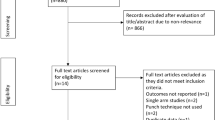Abstract
To describe a new Baha surgical procedure (Modified Punch Technique) with a smaller punch hole, a minimal incision and the use of the hydroxyapatite-coated abutment (BIA400). Retrospective chart review. Patients were implanted between 2012 and 2013 at King Abdulaziz University Hospital (Kingdom of Saudi Arabia). Eligible for initial or replacement bone-anchored hearing system; includes six patients (four adults, two children). Baha surgery using the Punch Method is described. The mean surgical time was 12.33 min (range 6–30), without the single outlier, it was 8.8 min. Bleeding was significant but easily controlled in two patients only. Depending on the postauricular subcutaneous thickness, the sizes of abutment used were 6, 8, 10 or 12 mm. None of the patients experienced severe pain. The postoperative follow-up period was 7 months for one patient, 5 months for three patients, and 3 months for two patients. First report of combined Modified Punch Technique with the BIA400 abutment is minimally invasive, reduces surgical time and results in faster healing and reduced likelihood of postoperative numbness.






Similar content being viewed by others
References
Snik AF, Mylanus EA, Proops DW, Wolfaardt JF, Hodgetts WE, Somers T, Niparko JK, Wazen JJ, Sterkers O, Cremers CW, Tjellström A (2005) Consensus statements on the BAHA system: Where do we stand at present? Ann Otol Rhinol Laryngol Suppl 195:2–12
Stalfors J, Tjellström A (2008) Skin reactions after BAHA surgery: a comparison between the U-graft technique and the BAHA dermatome. Otol Neurotol 29(8):1109–1114
de Wolf MJ, Hol MK, Huygen PL, Mylanus EA, Cremers CW (2008) Clinical outcome of the simplified surgical technique for Baha implantation. Otol Neurotol 29(8):1100–1108
Wilkie MD, Chakravarthy KM, Mamais C, Temple RH (2014) Osseointegrated hearing implant surgery using a novel hydroxyapatite-coated concave abutment design. Otolaryngol Head Neck Surg 151(6):1014–1019
Gordon SA, Coelho DH (2015) Minimally invasive surgery for osseointegrated auditory implants: a comparison of linear versus punch techniques. Otolaryngol Head Neck Surg 152(6):1089–1093
Proops D (1996) The Birmingham bone anchored hearing aid programme: surgical methods and complications. J Laryngol Otol 21:7–12
Reyes RA, Tjellström A, Granström G (2000) Evaluation of implant losses and skin reactions around extraoral bone anchored implants: A 0- to 8-year follow-up. Otolaryngol Head Neck Surg 122:272–276
Badran K, Arya AK, Bunstone D, Mackinnon N (2009) Long-term complications of bone-anchored hearing aids: a 14-year experience. J Laryngol Otol 123:170–176
de Wolf MJ, Hol MK, Huygen PL, Mylanus EA, Cremers CW (2009) Nijmegen results with application of a bone-anchored hearing aid in children: simplified surgical technique. Ann Otol Rhinol Laryngol 117(11):805–814
House JW, Kutz JW Jr (2007) Bone-anchored hearing aids: incidence and management of postoperative complications. Otol Neurotol 28:213–217
van der Pouw CT, Mylanus EA, Cremers CW (1999) Percutaneous implants in the temporal bone for securing a bone conductor: surgical methods and results. Ann Otol Rhinol Laryngol 108(6):532–536
Goldman RA, Georgolios A, Shaia WT (2013) The punch method for bone-anchored hearing aid placement. Otolaryngol Head Neck Surg 148(5):878–880
Bovo R (2008) Simplified technique without skin flap for the bone-anchored hearing aid (Baha®) implant. Acta Otorhinolaryngol ItaI 28:252–255
Wilkinson EP, Luxford WM, Slattery WH, De la Cruz A, House JW, Fayad JN (2009) Single vertical incision for Baha implant surgery: preliminary results. Otolaryngol Head Neck Surg 1401:573–578
de Wolf MJ, Hol MK, Mylanus Mylanus EA, Cremers CW (2009) Bone-anchored hearing aid surgery in older adults: implant loss and skin reactions. Ann Otol Rhinol Laryngol 118(7):525–531
Author information
Authors and Affiliations
Corresponding author
Ethics declarations
Conflict of interest
Hassan Alshehri, Abdulrahman Alsanosi, and Osama Majdalawieh declare that they have no conflict of interest.
Ethical Approval
This study was approved by the Institutional Review Board (IRB), King Saud University, College of Medicine, Riyadh.
Informed Consent
All subjects, or their legal guardian, had previously granted consent to the use of relevant data.
Rights and permissions
About this article
Cite this article
Alshehri, H., Alsanosi, A. & Majdalawieh, O. Modified Baha Punch Technique: Least Invasive, Shortest Time and No Suturing. Indian J Otolaryngol Head Neck Surg 68, 80–86 (2016). https://doi.org/10.1007/s12070-015-0929-1
Received:
Accepted:
Published:
Issue Date:
DOI: https://doi.org/10.1007/s12070-015-0929-1




